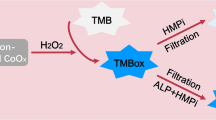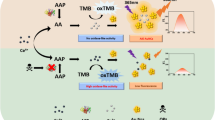Abstract
The development of nanozyme-based photothermometric sensing for point-of-care testing (POCT) heavy metal ions is of great significance for disease diagnosis and health management. Considering the low catalytic activity of most nanozymes at physiological pH, we found bismuth ions (Bi3+) could effectively enhance the peroxidase (POX)-like activity of cetyltrimethylammonium bromide and citrate-capped octahedral gold nanoparticle (CTAB/Cit-AuNP) nanozymes. It is mainly based on Bi3+ ions being able to trigger the surface cleaning effect of CTAB/Cit-AuNPs. Because the more active Bi3+ ions could effectively bind with citrate on the gold surface and competitively destroy the electrostatic interaction between citrate and CTAB, resulting in the removal of CTAB ligands from the gold surface. Without the ligand protection, CTAB/Cit-AuNPs aggregated immediately, and further resulted in a significant activation of the POX-like activity of AuNP nanozymes. Based on this principle, we introduced the enzyme substrate 3,3′,5,5′-tetramethylbenzidine (TMB) into this aggregation-induced nanozyme system, and rationally designed a photothermometric platform to quickly and sensitively detect Bi3+ ions by using the good photothermal effect of the oxidation product of TMB (oxTMB). The developed photothermometric method only using a common thermometer has a limit of detection (LOD) as low as 45.7 nM for POCT analysis of Bi3+ ions. This study not only provides a more accurate understanding of the aggregation-induced nanozymes based on the surface cleaning principle, but also shows the potential applications of aggregation-induced nanozymes in the POCT field.








Similar content being viewed by others
References
Mohan R. Green bismuth. Nat Chem. 2010;2(4):336. https://doi.org/10.1038/nchem.609.
Zhang Y, Li Q, Guo P, Zhang E, Wu K, Liu Y, et al. Fluorescence-enhancing film sensor for highly effective detection of Bi3+ ions based on SiO2 inverse opal photonic crystals. J Mater Chem C. 2018;6(27):7326–32. https://doi.org/10.1039/c8tc01461b.
Ramasamy K, Thambusamy S. Dual emission and pH based naphthalimide derivative fluorescent sensor for the detection of Bi3+. Sensors Actuators B Chem. 2017;247:632–40. https://doi.org/10.1016/j.snb.2017.03.043.
Alizadeh T, Hamidi N, Ganjali MR, Nourozi P. Development of a highly selective and sensitive electrochemical sensor for Bi3+ determination based on nano-structured bismuth-imprinted polymer modified carbon/carbon nanotube paste electrode. Sensors Actuators B Chem. 2017;245:605–14. https://doi.org/10.1016/j.snb.2017.02.024.
Lei P, An R, Zhang P, Yao S, Song S, Dong L, et al. Ultrafast synthesis of ultrasmall poly(vinylpyrrolidone)-protected bismuth nanodots as a multifunctional theranostic agent for in vivo dual-modal CT/photothermal-imaging-guided photothermal therapy. Adv Funct Mater. 2017;27(35):1702018. https://doi.org/10.1002/adfm.201702018.
Lei P, Zhang P, Yuan Q, Wang Z, Dong L, Song S, et al. Yb3+/Er3+-codoped Bi2O3 nanospheres: probe for upconversion luminescence imaging and binary contrast agent for computed tomography imaging. ACS Appl Mater Interfaces. 2015;7(47):26346–54. https://doi.org/10.1021/acsami.5b09990.
Gao X, Zhao H, Zhao X, Li Z, Gao Z, Wang Y, et al. Aqueous phase sensing of bismuth ion using fluorescent metal-organic framework. Sensors Actuators B Chem. 2018;266:323–8. https://doi.org/10.1016/j.snb.2018.03.139.
Jia Y, Mou Q, Yu Y, Shi Z, Huang Y, Ni S, et al. Reduction of interferences using Fe-containing metal-organic frameworks for matrix separation and enhanced photochemical vapor generation of trace bismuth. Anal Chem. 2019;91(8):5217–24. https://doi.org/10.1021/acs.analchem.8b05893.
Yu Y, Jia Y, Shi Z, Chen Y, Ni S, Wang R, et al. Enhanced photochemical vapor generation for the determination of bismuth by inductively coupled plasma mass spectrometry. Anal Chem. 2018;90(22):13557–63. https://doi.org/10.1021/acs.analchem.8b03681.
Ribeiro LAR, Pradela-Filho LA, Fonseca WT, Araújo DAG, Assunção RMN, Takeuchi RM, et al. Square wave voltammetry enables fast quantification and evaluation of Bi3+ extraction from eyeshadow samples. Anal Methods. 2017;9(25):3831–8. https://doi.org/10.1039/C7AY01077J.
Zhang E, Ju P, Li Q, Hou X, Yang H, Yang X, et al. A novel rhodamine 6G-based fluorescent and colorimetric probe for Bi3+: synthesis, selectivity, sensitivity and potential applications. Sensors Actuators B Chem. 2018;260:204–12. https://doi.org/10.1016/j.snb.2017.12.109.
Mohammadi S, Khayatian G. Colorimetric detection of Bi (III) in water and drug samples using pyridine-2,6-dicarboxylic acid modified silver nanoparticles. Spectrochim Acta A Mol Biomol Spectrosc. 2015;148:405–11. https://doi.org/10.1016/j.saa.2015.03.127.
Deng HH, Luo BY, He SB, Chen RT, Lin Z, Peng HP, et al. Redox recycling-triggered peroxidase-like activity enhancement of bare gold nanoparticles for ultrasensitive colorimetric detection of rare-earth Ce(3+) ion. Anal Chem. 2019;91(6):4039–46. https://doi.org/10.1021/acs.analchem.8b05552.
Zhang X, Liu W, Li X, Zhang Z, Shan D, Xia H, et al. Ultrahigh selective colorimetric quantification of chromium(VI) ions based on gold amalgam catalyst oxidoreductase-like activity in water. Anal Chem. 2018;90(24):14309–15. https://doi.org/10.1021/acs.analchem.8b03597.
Naveen Prasad S, Weerathunge P, Karim MN, Anderson S, Hashmi S, Mariathomas PD, et al. Non-invasive detection of glucose in human urine using a color-generating copper nanozyme. Anal Bioanal Chem. 2021;413:1279–91. https://doi.org/10.1007/s00216-020-03090-w.
Fu G, Sanjay ST, Zhou W, Brekken RA, Kirken RA, Li X. Exploration of nanoparticle-mediated photothermal effect of TMB-H2O2 colorimetric system and its application in a visual quantitative photothermal immunoassay. Anal Chem. 2018;90(9):5930–7. https://doi.org/10.1021/acs.analchem.8b00842.
Zhou W, Hu K, Kwee S, Tang L, Wang Z, Xia J, et al. Gold nanoparticle aggregation-induced quantitative photothermal biosensing using a thermometer: a simple and universal biosensing platform. Anal Chem. 2020;92(3):2739–47. https://doi.org/10.1021/acs.analchem.9b04996.
Guo H, Su X, Su Q, Zhuang W, You Z. Au-coated Fe3O4 core-shell nanohybrids with photothermal activity for point-of-care immunoassay for lipoprotein-associated phospholipase A2 on a digital near-infrared thermometer. Anal Bioanal Chem. 2021;413(1):235–44. https://doi.org/10.1007/s00216-020-02995-w.
Hong G, Zhang D, He Y, Yang Y, Chen P, Yang H, et al. New photothermal immunoassay of human chorionic gonadotropin using Prussian blue nanoparticle-based photothermal conversion. Anal Bioanal Chem. 2019;411(26):6837–45. https://doi.org/10.1007/s00216-019-02049-w.
Liu D, Tu Q, Han Y, Wang X, Kang Q, Wang P, et al. A dual-modal colorimetric and photothermal assay for glutathione based on MnO2 nanosheets synthesized with eco-friendly materials. Anal Bioanal Chem. 2020;412(30):8443–50. https://doi.org/10.1007/s00216-020-02982-1.
Huang Y-Q, Fu S, Wang Y-S, Xue J-H, Xiao X-L, Chen S-H, et al. Protamine-gold nanoclusters as peroxidase mimics and the selective enhancement of their activity by mercury ions for highly sensitive colorimetric assay of Hg(II). Anal Bioanal Chem. 2018;410(28):7385–94. https://doi.org/10.1007/s00216-018-1344-8.
He S-B, Chen F-Q, Xiu L-F, Peng H-P, Deng H-H, Liu A-L, et al. Highly sensitive colorimetric sensor for detection of iodine ions using carboxylated chitosan–coated palladium nanozyme. Anal Bioanal Chem. 2020;412(2):499–506. https://doi.org/10.1007/s00216-019-02270-7.
Wu G-W, Shen Y-M, Shi X-Q, Deng H-H, Zheng X-Q, Peng H-P, et al. Bimetallic Bi/Pt peroxidase mimic and its bioanalytical applications. Anal Chim Acta. 2017;971:88–96. https://doi.org/10.1016/j.aca.2017.03.028.
Gao M, An P, Rao H, Niu Z, Xue X, Luo M, et al. Molecule-gated surface chemistry of Pt nanoparticles for constructing activity-controllable nanozymes and a three-in-one sensor. Analyst. 2020;145(4):1279–87. https://doi.org/10.1039/c9an01956a.
Wei H, Wang E. Nanomaterials with enzyme-like characteristics (nanozymes): next-generation artificial enzymes. Chem Soc Rev. 2013;42(14):6060–93. https://doi.org/10.1039/c3cs35486e.
Wu J, Wang X, Wang Q, Lou Z, Li S, Zhu Y, et al. Nanomaterials with enzyme-like characteristics (nanozymes): next-generation artificial enzymes (II). Chem Soc Rev. 2019;48(4):1004–76. https://doi.org/10.1039/c8cs00457a.
Zhang J, Wu S, Lu X, Wu P, Liu J. Manganese as a catalytic mediator for photo-oxidation and breaking the pH limitation of nanozymes. Nano Lett. 2019;19(5):3214–20. https://doi.org/10.1021/acs.nanolett.9b00725.
Huang Y, Ren J, Qu X. Nanozymes: classification, catalytic mechanisms, activity regulation, and applications. Chem Rev. 2019;119(6):4357–412. https://doi.org/10.1021/acs.chemrev.8b00672.
An P, Rao H, Gao M, Xue X, Liu X, Lu X, et al. Simply translating mercury detection into a temperature measurement: using an aggregation-activated oxidase-like activity of gold nanoparticles. Chem Commun. 2020;56(68):9799–802. https://doi.org/10.1039/D0CC01445A.
Liao H, Liu G, Liu Y, Li R, Fu W, Hu L. Aggregation-induced accelerating peroxidase-like activity of gold nanoclusters and their applications for colorimetric Pb2+ detection. Chem Commun. 2017;53(73):10160–3. https://doi.org/10.1039/C7CC05409B.
Ni P, Dai H, Wang Y, Sun Y, Shi Y, Hu J, et al. Visual detection of melamine based on the peroxidase-like activity enhancement of bare gold nanoparticles. Biosens Bioelectron. 2014;60:286–91. https://doi.org/10.1016/j.bios.2014.04.029.
Chang CC, Wu HL, Kuo CH, Huang MH. Hydrothermal synthesis of monodispersed octahedral gold nanocrystals with five different size ranges and their self-assembled structures. Chem Mater. 2008;20(24):7570–4.
Zhang Z, Li W, Zhao Q, Cheng M, Xu L, Fang X. Highly sensitive visual detection of copper (II) using water-soluble azide-functionalized gold nanoparticles and silver enhancement. Biosens Bioelectron. 2014;59:40–4. https://doi.org/10.1016/j.bios.2014.03.003.
Lien CW, Huang CC, Chang HT. Peroxidase-mimic bismuth-gold nanoparticles for determining the activity of thrombin and drug screening. Chem Commun. 2012;48(64):7952–4. https://doi.org/10.1039/c2cc32833j.
Liu X, Cao H, Yin J. Generation and photocatalytic activities of Bi@Bi2O3 microspheres. Nano Res. 2011;4(5):470–82. https://doi.org/10.1007/s12274-011-0103-3.
Lien CW, Tseng YT, Huang CC, Chang HT. Logic control of enzyme-like gold nanoparticles for selective detection of lead and mercury ions. Anal Chem. 2014;86(4):2065–72. https://doi.org/10.1021/ac4036789.
Sun X, Liu R, Liu Q, Fei Q, Feng G, Shan H, et al. Colorimetric sensing of mercury (II) ion based on anti-aggregation of gold nanoparticles in the presence of hexadecyl trimethyl ammonium bromide. Sensors Actuators B Chem. 2018;260:998–1003. https://doi.org/10.1016/j.snb.2018.01.083.
Liu D, Chen W, Tian Y, He S, Zheng W, Sun J, et al. A highly sensitive gold-nanoparticle-based assay for acetylcholinesterase in cerebrospinal fluid of transgenic mice with Alzheimer’s disease. Adv Healthc Mater. 2012;1(1):90–5. https://doi.org/10.1002/adhm.201100002.
Ojea-Jiménez I, Puntes V. Instability of cationic gold nanoparticle bioconjugates: the role of citrate ions. J Am Chem Soc. 2009;131(37):13320–7. https://doi.org/10.1021/ja902894s.
Lin C-Y, Yu C-J, Lin Y-H, Tseng W-L. Colorimetric sensing of silver(I) and mercury(II) ions based on an assembly of tween 20-stabilized gold nanoparticles. Anal Chem. 2010;82(16):6830–7. https://doi.org/10.1021/ac1007909.
Funding
We gratefully acknowledge the financial support from the National Natural Science Foundation of China (22064014, 21765013).
Author information
Authors and Affiliations
Corresponding authors
Ethics declarations
Ethics approval and consent to participate
We state that all the experiments related to the human serum were performed in accordance with the guidelines on administration of our lab, and approved by the ethics committee at Northwest Normal University, and informed consent was obtained from the human volunteers participating in the present study.
Conflict of interest
The authors declare no competing interests.
Additional information
Publisher’s note
Springer Nature remains neutral with regard to jurisdictional claims in published maps and institutional affiliations.
Supplementary information
Supplementary data associated with this article can be found, in the online version, at http://dx.doi.org/xxx.
ESM 1
(PDF 534 kb)
Rights and permissions
About this article
Cite this article
Zhang, K., Zhou, X., Xue, X. et al. Photothermometric analysis of bismuth ions using aggregation-induced nanozyme system with a target-triggered surface cleaning effect. Anal Bioanal Chem 413, 3655–3665 (2021). https://doi.org/10.1007/s00216-021-03312-9
Received:
Revised:
Accepted:
Published:
Issue Date:
DOI: https://doi.org/10.1007/s00216-021-03312-9




